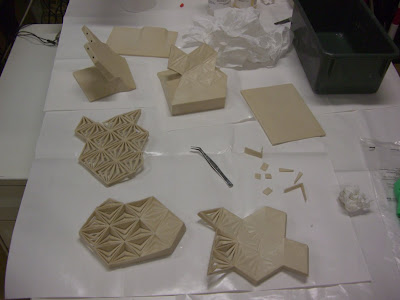These are some images of my competition entry for the street furniture competition organized by Architecture for Humanity in Chicago. My work was chosen among the finalists.
tomos (Greek word for “cut”) answers to the need for redevelopment of underutilized spaces with a multiplicity of different solutions. Infinite opportunity of utilize at user’s disposal are embedded in this single object.
Its complex morphology creates diversified spaces such as:
- seats with different height (for adults and children)
- an horizontal plane useable as a table
- inclined surfaces for relax and sport
Prerogrative of tomos is to supply a variety of function in order to integrate itself in every situation and contribute to the redevelopment of different neglected spaces.
Structure of tomos is based on principle of tomography: section with 2 cm of thickness are placed in series with a distance of 2 cm from each other. In this way is maintained fluidity in object’s morphology and a remarkable ergonomic comfort in the seats. This is also a solution for saving a considerable amount of material.
A single tomos (length 470 cm) is composed by 117 pieces, obtained from 6 PVC sheets (dimension 200 x 300 cm). Productive process is optimized clustering pieces in each sheet in order to minimize waste. In each piece are designed holes in which will be inserted steel bars with a diameter of 2.5 cm in order to guarantee cohesion and lengthwise stiffness to the entire structure. Bolts, with a thickness of 2 cm, will be placed among the section to maintain them in the desired distance (2 cm).
A CNC milling machine is utilized to obtain all the pieces from 6 PVC sheets. During the cut every single section is identified with a code (carved on its surface), that determines its assembly order and assure a considerable speed in this operation.
Sections that compose tomos are moulded in order to guarantee high resistance performances to external stresses exploiting less amount of material; moreover PVC owns excellent features of recycle so that discards produced during manufacturing process can be straight recycled. Simplicity in assembly operation was studied in order to permit a future disassembly of the structure and its reuse in the following season. If this will not take place, all the structure will be recycled considering that PVC and steel are material with excellent features of recycle.
Its complex morphology creates diversified spaces such as:
- seats with different height (for adults and children)
- an horizontal plane useable as a table
- inclined surfaces for relax and sport
Prerogrative of tomos is to supply a variety of function in order to integrate itself in every situation and contribute to the redevelopment of different neglected spaces.
Structure of tomos is based on principle of tomography: section with 2 cm of thickness are placed in series with a distance of 2 cm from each other. In this way is maintained fluidity in object’s morphology and a remarkable ergonomic comfort in the seats. This is also a solution for saving a considerable amount of material.
A single tomos (length 470 cm) is composed by 117 pieces, obtained from 6 PVC sheets (dimension 200 x 300 cm). Productive process is optimized clustering pieces in each sheet in order to minimize waste. In each piece are designed holes in which will be inserted steel bars with a diameter of 2.5 cm in order to guarantee cohesion and lengthwise stiffness to the entire structure. Bolts, with a thickness of 2 cm, will be placed among the section to maintain them in the desired distance (2 cm).
A CNC milling machine is utilized to obtain all the pieces from 6 PVC sheets. During the cut every single section is identified with a code (carved on its surface), that determines its assembly order and assure a considerable speed in this operation.
Sections that compose tomos are moulded in order to guarantee high resistance performances to external stresses exploiting less amount of material; moreover PVC owns excellent features of recycle so that discards produced during manufacturing process can be straight recycled. Simplicity in assembly operation was studied in order to permit a future disassembly of the structure and its reuse in the following season. If this will not take place, all the structure will be recycled considering that PVC and steel are material with excellent features of recycle.













































